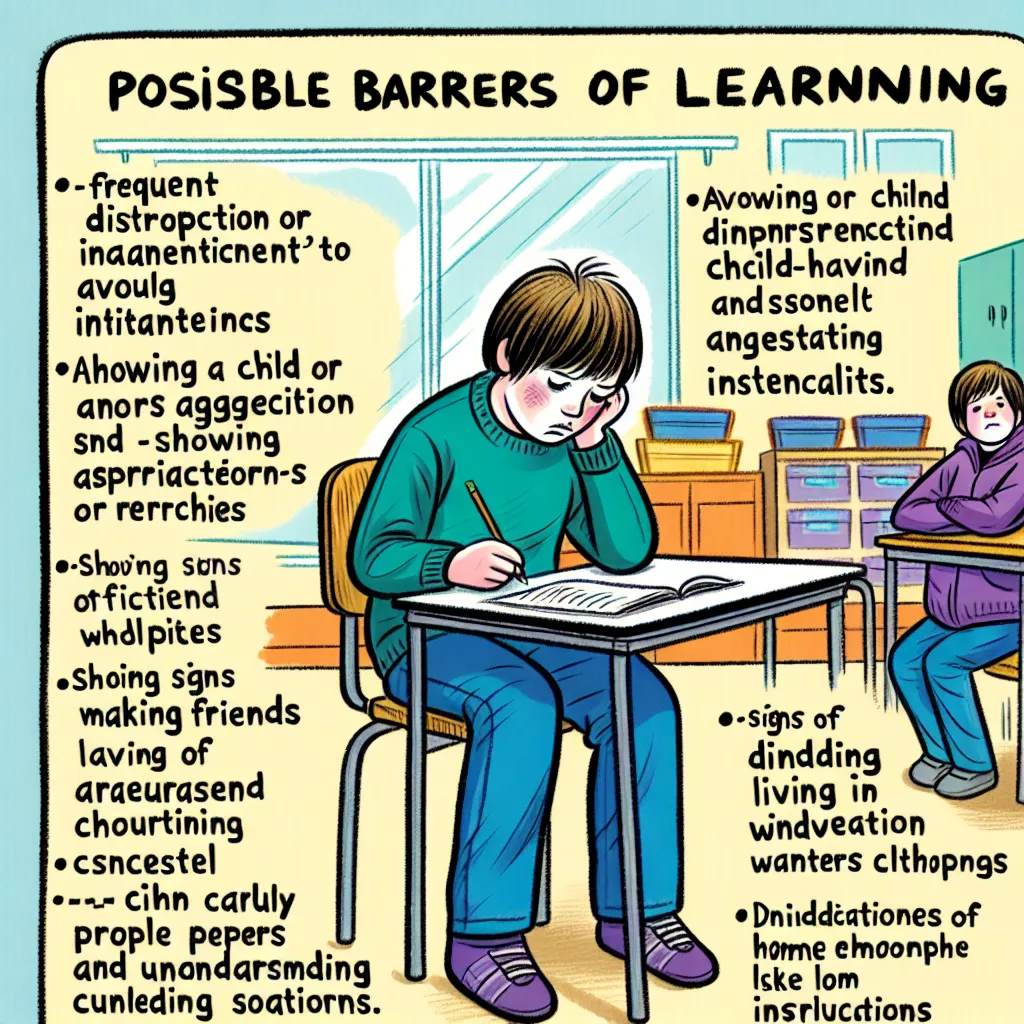Ask AI on The Internet
Question: Observe a learner who experiences barriers to learning. List the aspects that you have identified in the learner's behaviour, appearance and/or conduct that may indicate possible barriers to learning. 4.1 Behaviour in class 4.2 Emotional signs (e.g., aggressive towards other learners) 4.3 Appearance (e.g., neglected) 4.4 Social interaction and relationships (e.g., no friends in class) 4.5 Intellectual capabilities (e.g., very slow learner, poor language development) 4.6 Other aspects (e.g., part of a child-headed household)
Certainly, observing and identifying potential barriers to learning is crucial in providing the necessary support to learners. Here's a comprehensive list of aspects that might indicate possible barriers across various categories: ### 4.1 Behaviour in Class - **Disruptive Actions:** Frequently disrupting the class or seeking attention in inappropriate ways. - **Lack of Engagement:** Appears disinterested or unmotivated in classroom activities. - **Disorganization:** Struggles with keeping track of materials, assignments, and due dates. - **Frequent Absences or Tardiness:** Regularly missing classes or arriving late. ### 4.2 Emotional Signs - **Aggression:** Exhibits aggressive behavior towards other learners or teachers. - **Mood Swings:** Shows extreme or frequent changes in mood, such as sudden sadness or irritability. - **Withdrawal:** Tends to isolate themselves, not participating in class discussions or group activities. - **Anxiety:** Appears anxious, nervous, or overly worried about academic performance or social interactions. ### 4.3 Appearance - **Neglect:** Appears to have poor hygiene or is consistently in unclean or inappropriate clothing for the weather. - **Fatigue:** Frequently looks tired or falls asleep during lessons. - **Physical Signs of Stress:** Exhibits physical signs such as nail-biting, hair-pulling, or other nervous habits. ### 4.4 Social Interaction and Relationships - **Isolation:** Does not engage with peers and often spends time alone during breaks or group activities. - **Conflict:** Frequently involved in conflicts or misunderstandings with classmates. - **Lack of Support:** Appears to lack a support network of friends or trusted adults in the school environment. ### 4.5 Intellectual Capabilities - **Slow Progress:** Demonstrates slower-than-average progress in learning new concepts or skills. - **Poor Language Development:** Struggles with language-related tasks, whether in comprehension, speaking, reading, or writing. - **Memory Issues:** Has difficulty remembering instructions, facts, or tasks that have been previously covered. - **Learning Disabilities:** Shows signs of specific learning disabilities such as dyslexia, dyscalculia, or ADHD. ### 4.6 Other Aspects - **Family Circumstances:** Part of a child-headed household, or has significant family responsibilities that impact learning. - **Economic Constraints:** Comes from a low-income household, potentially lacking access to basic needs and educational resources. - **Health Issues:** May have medical conditions, including chronic illnesses or disabilities that affect their learning. - **Language Barrier:** Learner's primary language is different from the language of instruction, making it harder to follow lessons and complete tasks. - **Environmental Factors:** Experiences instability at home, such as domestic violence, homelessness, or frequent relocations. Identifying these signs is the first step in providing appropriate interventions and support tailored to the specific needs of the learner. Collaboration with parents, caregivers, and educational specialists is essential to create an effective support system.
Think your answer is better than the AI's? Post it below.
Other Most Relevant Posts:
Question Tags
If you want your question answered by an AI, click here.







Post your own comment: